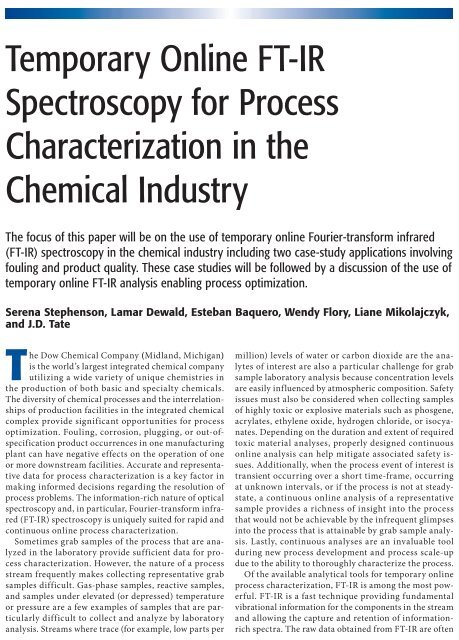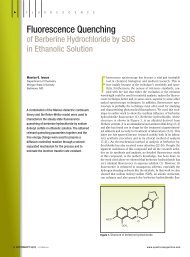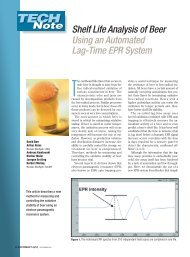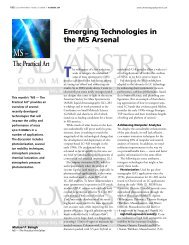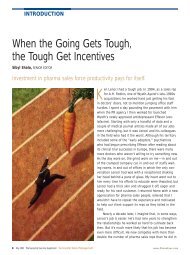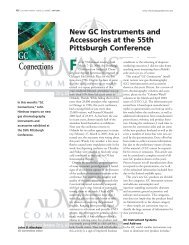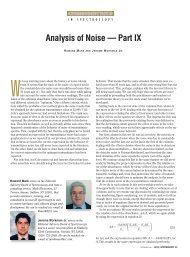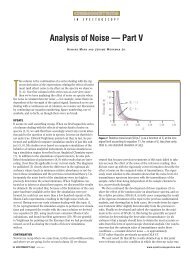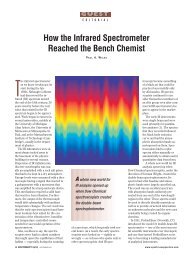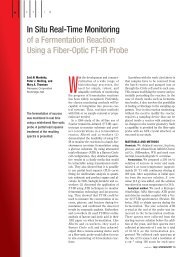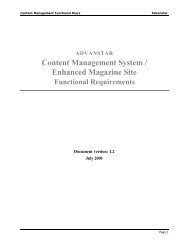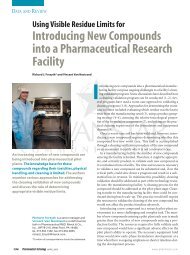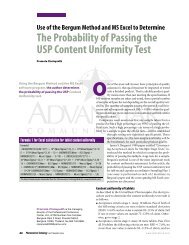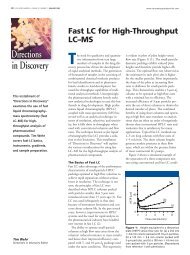2012 Corporate Capabilities - Spectroscopy
2012 Corporate Capabilities - Spectroscopy
2012 Corporate Capabilities - Spectroscopy
Create successful ePaper yourself
Turn your PDF publications into a flip-book with our unique Google optimized e-Paper software.
www.spectroscopyonline.com<br />
December 2011 <strong>Spectroscopy</strong> 26(12) 21<br />
Temporary Online FT-IR<br />
<strong>Spectroscopy</strong> for Process<br />
Characterization in the<br />
Chemical Industry<br />
The focus of this paper will be on the use of temporary online Fourier-transform infrared<br />
(FT-IR) spectroscopy in the chemical industry including two case-study applications involving<br />
fouling and product quality. These case studies will be followed by a discussion of the use of<br />
temporary online FT-IR analysis enabling process optimization.<br />
Serena Stephenson, Lamar Dewald, Esteban Baquero, Wendy Flory, Liane Mikolajczyk,<br />
and J.D. Tate<br />
The Dow Chemical Company (Midland, Michigan)<br />
is the world’s largest integrated chemical company<br />
utilizing a wide variety of unique chemistries in<br />
the production of both basic and specialty chemicals.<br />
The diversity of chemical processes and the interrelationships<br />
of production facilities in the integrated chemical<br />
complex provide significant opportunities for process<br />
optimization. Fouling, corrosion, plugging, or out-ofspecification<br />
product occurrences in one manufacturing<br />
plant can have negative effects on the operation of one<br />
or more downstream facilities. Accurate and representative<br />
data for process characterization is a key factor in<br />
making informed decisions regarding the resolution of<br />
process problems. The information-rich nature of optical<br />
spectroscopy and, in particular, Fourier-transform infrared<br />
(FT-IR) spectroscopy is uniquely suited for rapid and<br />
continuous online process characterization.<br />
Sometimes grab samples of the process that are analyzed<br />
in the laboratory provide sufficient data for process<br />
characterization. However, the nature of a process<br />
stream frequently makes collecting representative grab<br />
samples difficult. Gas-phase samples, reactive samples,<br />
and samples under elevated (or depressed) temperature<br />
or pressure are a few examples of samples that are particularly<br />
difficult to collect and analyze by laboratory<br />
analysis. Streams where trace (for example, low parts per<br />
million) levels of water or carbon dioxide are the analytes<br />
of interest are also a particular challenge for grab<br />
sample laboratory analysis because concentration levels<br />
are easily influenced by atmospheric composition. Safety<br />
issues must also be considered when collecting samples<br />
of highly toxic or explosive materials such as phosgene,<br />
acrylates, ethylene oxide, hydrogen chloride, or isocyanates.<br />
Depending on the duration and extent of required<br />
toxic material analyses, properly designed continuous<br />
online analysis can help mitigate associated safety issues.<br />
Additionally, when the process event of interest is<br />
transient occurring over a short time-frame, occurring<br />
at unknown intervals, or if the process is not at steadystate,<br />
a continuous online analysis of a representative<br />
sample provides a richness of insight into the process<br />
that would not be achievable by the infrequent glimpses<br />
into the process that is attainable by grab sample analysis.<br />
Lastly, continuous analyses are an invaluable tool<br />
during new process development and process scale-up<br />
due to the ability to thoroughly characterize the process.<br />
Of the available analytical tools for temporary online<br />
process characterization, FT-IR is among the most powerful.<br />
FT-IR is a fast technique providing fundamental<br />
vibrational information for the components in the stream<br />
and allowing the capture and retention of informationrich<br />
spectra. The raw data obtained from FT-IR are often


